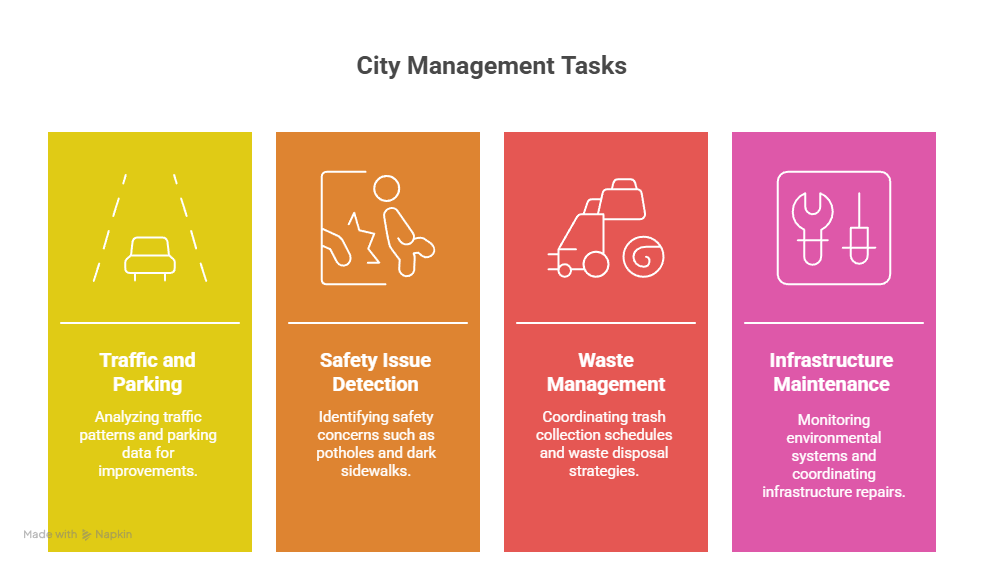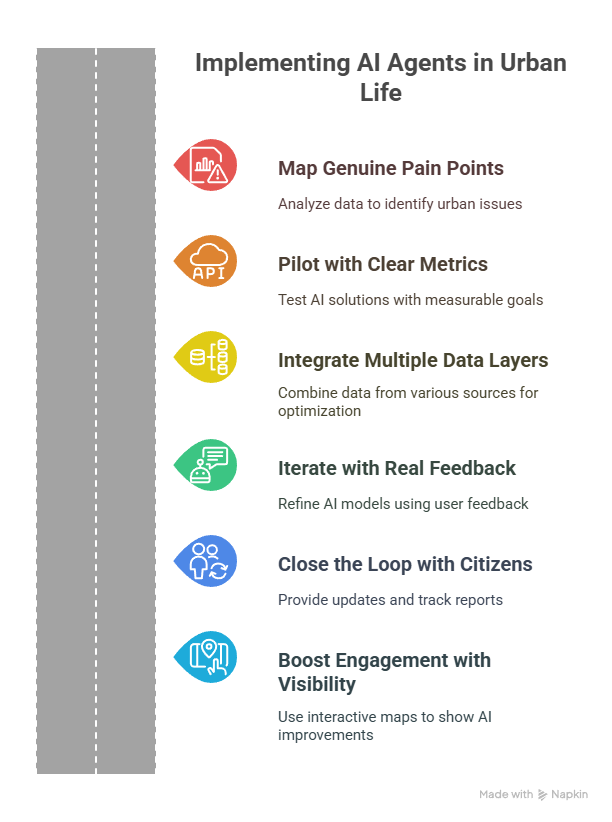AI agents are easing city living—optimizing transit, parking, trash collection, safety alerts, and resilience through real-time decision-making.
What Are AI Agents in Urban Life?
An AI agent is software that uses real-time data and autonomous decision-making to handle tasks without human control. In cities, these agents integrate sensors, cameras, and digital services to:
- Analyze traffic and parking data
- Detect safety issues like dark sidewalks or potholes
- Coordinate trash collection and infrastructure repairs
- Monitor environmental and citywide systems

By automating decisions, they smooth out everyday urban friction, making life feel both smarter and calmer.
Mia’s Smoother Commute with AI Traffic Flow
Meet Mia, a marketing executive who used to dread her morning drive from Oakland to San Francisco. Cruise control couldn’t fix gridlock or parking searches—but FlowSense, a new AI-powered transit assistant, could.
One fine Tuesday, the app recommended she take a shuttle to the train station instead. Within moments, coach notifications popped up: “Walk to stop A in 5 minutes, bus arriving in 7.” That day, traffic didn’t overwhelm her—and she stepped off the train calmly and on time.
Three-month results:
- Commute time dropped 15%
- Time spent looking for parking cut by 25%
- Reported stress during commute fell noticeably
How it works:
- Data gathering: vehicle GPS, IoT road sensors, transit feed
- Autonomous analysis: forecasts congestion; plans best route
- User guidance: dynamic, turn-by-turn, multimodal instructions
- Machine feedback: learns Mia’s route preferences automatically
Carlos’s Cleaner, Safer Neighborhood
Meet Carlos, a Phoenix resident living on a block with frequent streetlight outages and overflowing bins. His local council initiated CleanCity, an AI network connecting IoT sensors, sanitation trucks, and citizen reports.
Carlos once snapped a photo of a streetlight failing at dusk. Instantaneously, the AI created a repair ticket tagged high-priority. Within hours, utility crews arrived. Another morning, sensors flagged bins reaching capacity, prompting early pick-up—before midday heat.
Quarterly impact:
- 40% faster streetlight repairs
- 90% fewer trash overflow incidents
- 18% boost in resident satisfaction
Mechanism:
- Smart sensors gauge fill level and lighting
- Triage logic ranks alerts automatically
- Service tickets auto-generated and dispatched
- Citizen engagement via app reporting and tracking
Leah’s Safer Walk Home with Smart Safety
Meet Leah, a late‑night Chicago teacher uneasy about walking alone. The city deployed SafeWalk, a safety‑focused AI agent merging crime data, lighting sensors, and live street cameras.
One night, she received a phone alert: “Avoid Maple Lane—alternate route is better lit and more populated.” Leah followed the recommended route and arrived home peacefully, relieved.
Program results:
- 28% decrease in incidents along suggested routes
- 40% rise in app adoption
- Leah’s sense of security improved by 35%
How it operates:
- Data integration: real-time crime, lighting, foot traffic
- Risk modeling: AI scores and ranks each potential path
- Immediate guidance: sends safest route notice
- User feedback: confirms diverging preferences
Brisbane’s Smarter Signals Cut Commutes
In Brisbane, city authorities retrofitted intersections with AI-enabled traffic signals under the “Smarter Suburban Corridors” project. These signals adapt automatically based on live vehicle counts and congestion.
Pilot results:
- 20% reduction in travel times along pilot roads
Working model:
- Street sensors track vehicle flow
- AI algorithms adjust green-light timing
- Signal cycles adapt over time based on trends
Why AI Agents Shine in City Life
AI agents improve urban living by delivering:
- Real-time adaptability, not lagged manual fixes
- Dynamic coordination across transit, safety, and sanitation
- Predictive issue resolution, avoiding service delays
- Personalization, serving you—not bureaucracy
They aggregate data—from satellites to street-level sensors—to optimize everything from road congestion to environmental hazards .
Practical Tips for City Leaders
To deploy AI agents successfully, follow these concrete steps:
- Map genuine pain points
- Analyze complaint logs and surveys to locate traffic hotspots, unlit areas, or sanitation zones.
- Validate issues with static or mobile sensors.
- Pilot with clear metrics
- Select a small zone or single corridor for initial deployment.
- KPIs: reduce average commute time by 15%, halve streetlight outages, or boost cleanliness satisfaction.
- Integrate multiple data layers
- Use feeds from CCTV, transit systems, IoT bins, and public apps.
- Example: sync fleet GPS with bin sensor data to optimize routing.
- Iterate with real feedback
- Deploy small pilot models, retrain quarterly using updated data and user comments.
- A/B test different strategies per zone to refine outcomes.
- Close the loop with citizens
- Let users track their reports—seeing, for instance, when a streetlight gets fixed.
- Public dashboards showing live progress builds trust.
- Boost engagement with visibility
- Provide interactive city maps highlighting AI improvements (like real-time repairs).
- Offer residents updates (“Your report resolved!”) to show value created.

Conclusion
AI agents are reshaping how cities function—and easing urban stress. From seamless commutes to safer walks, these systems turn messy problems into manageable solutions. So if your city offers AI‑powered services, try them out and take part in building smoother urban systems. The future of stress-free city life is here—powered by intelligent agents and real-world action.
References
- “Smart Traffic Management Stats,” PatentPC, Jun 18 2025. https://patentpc.com/blog/smart-traffic-management
- “Brisbane’s Smart Corridors” pilot results, Brisbane Times, May 2025.
- “Urban Heat Island AI Challenge,” EY, 2025.
